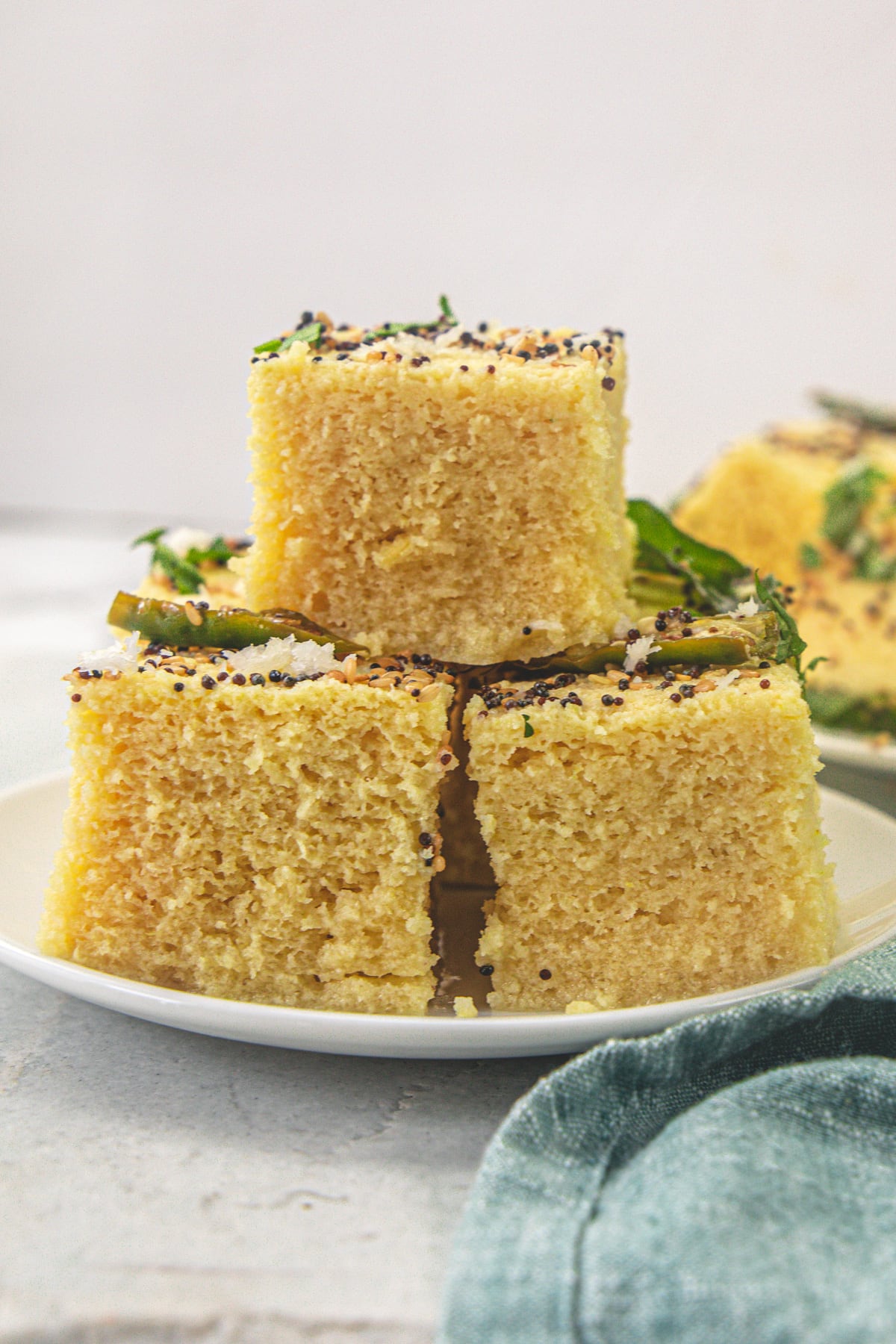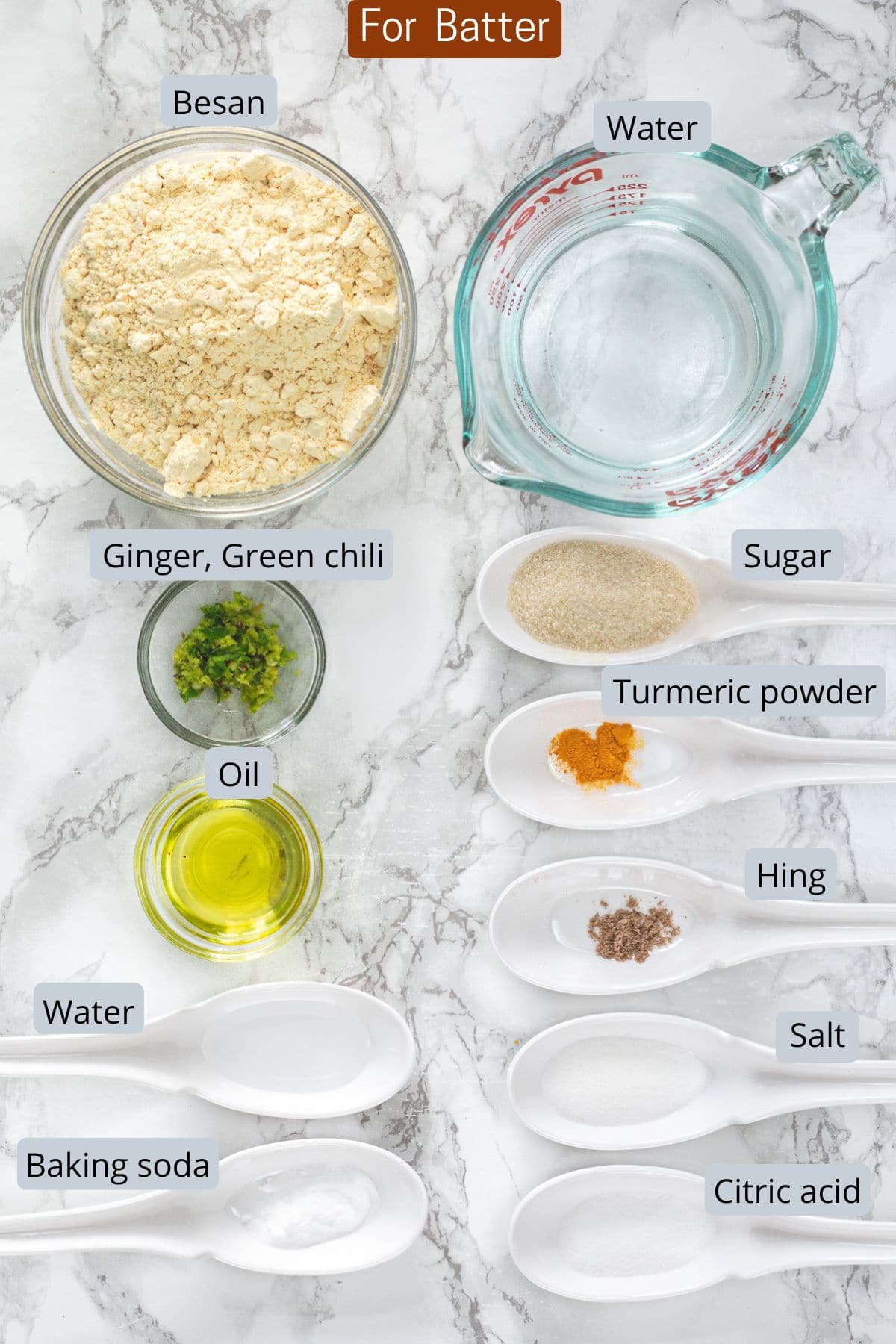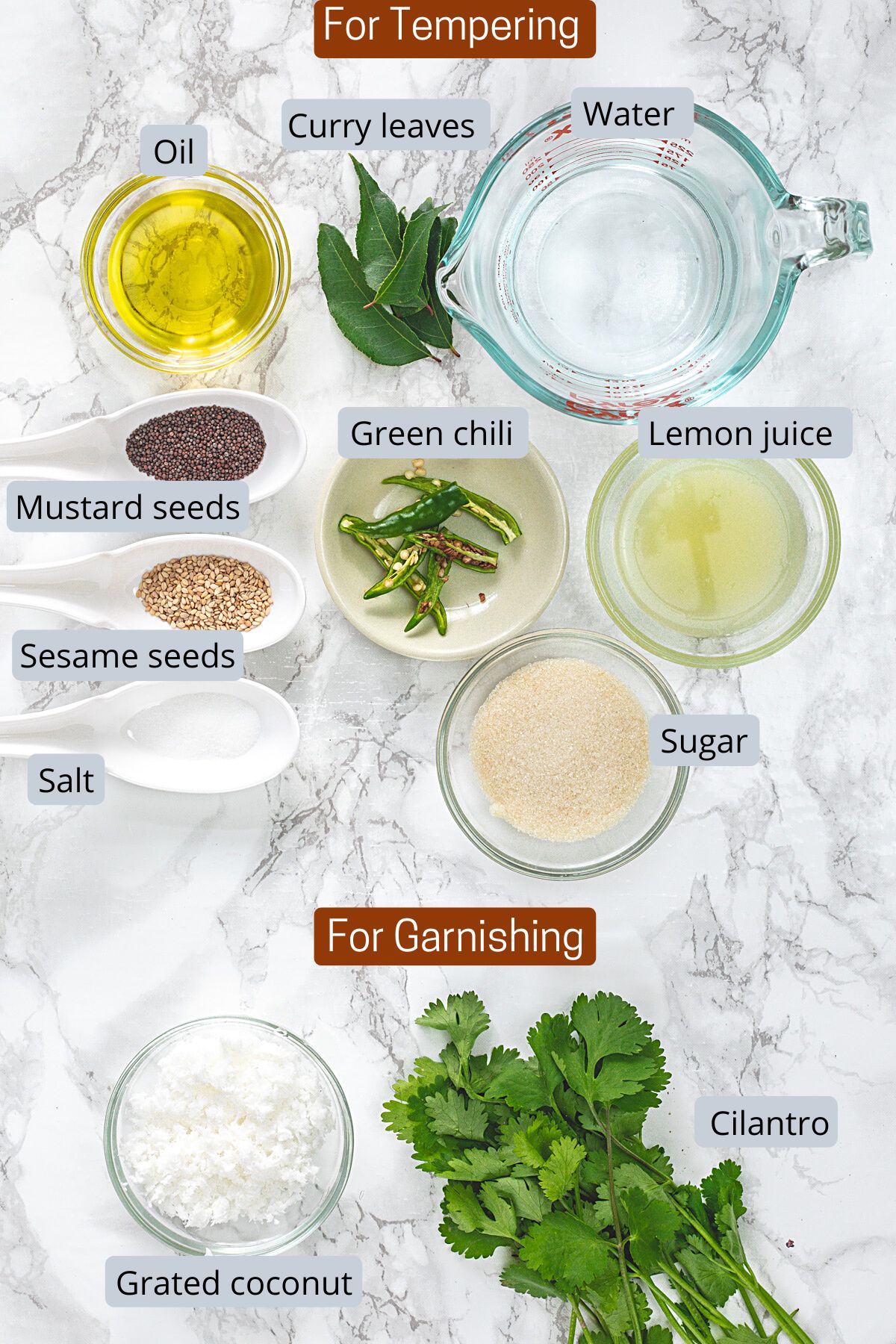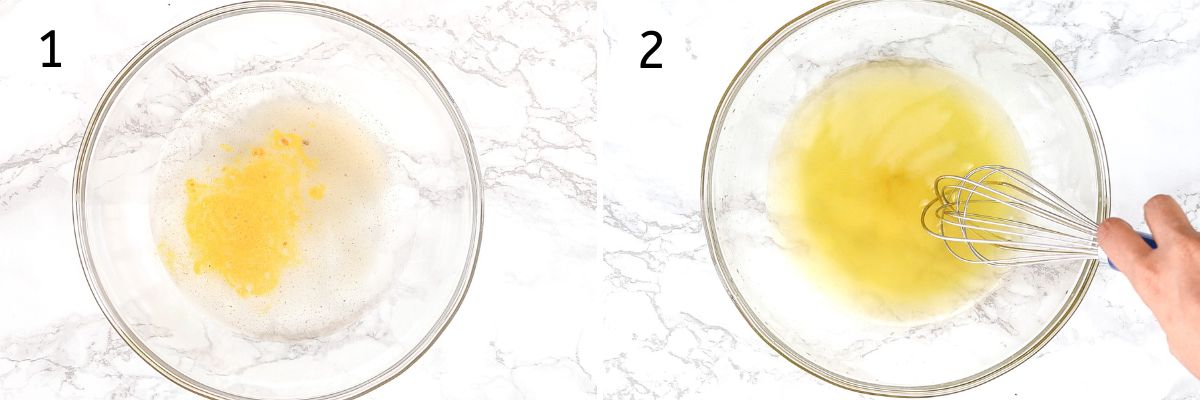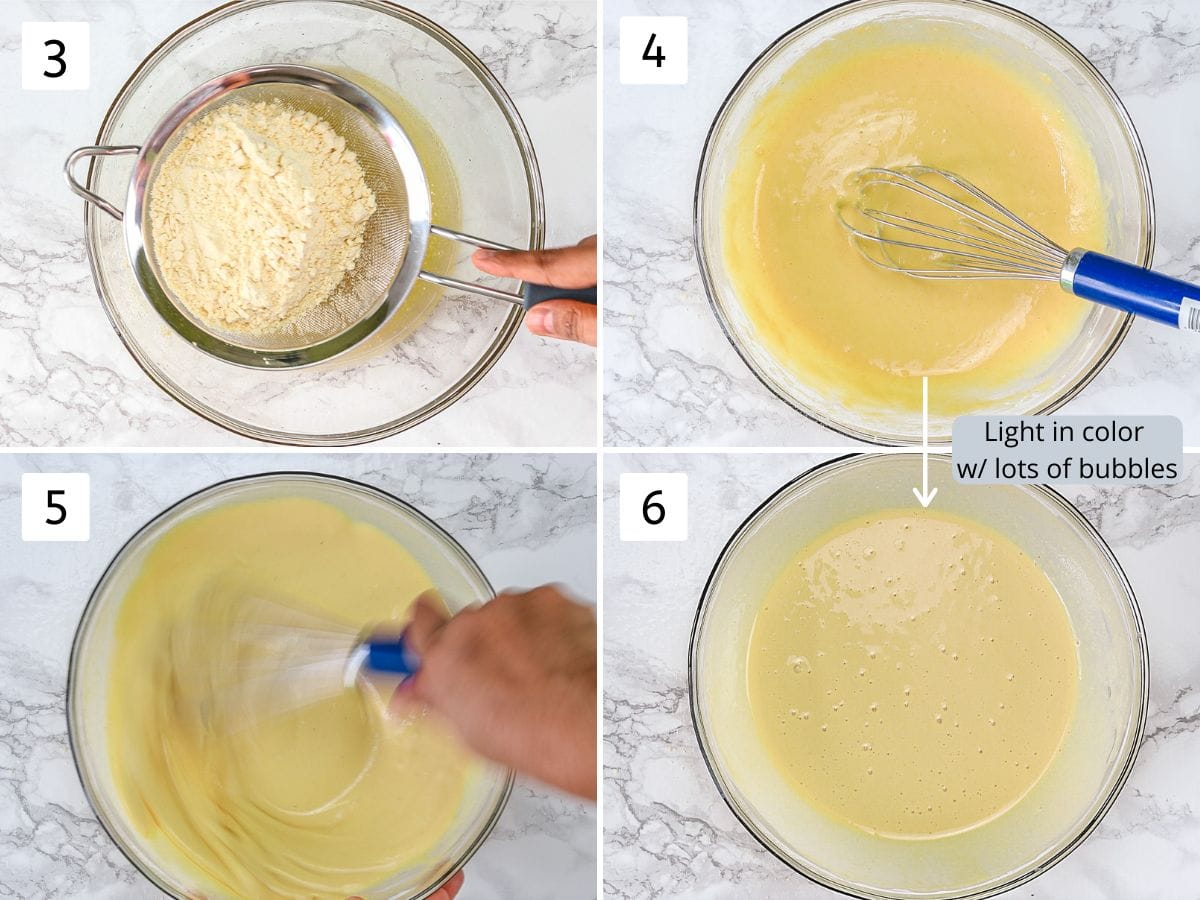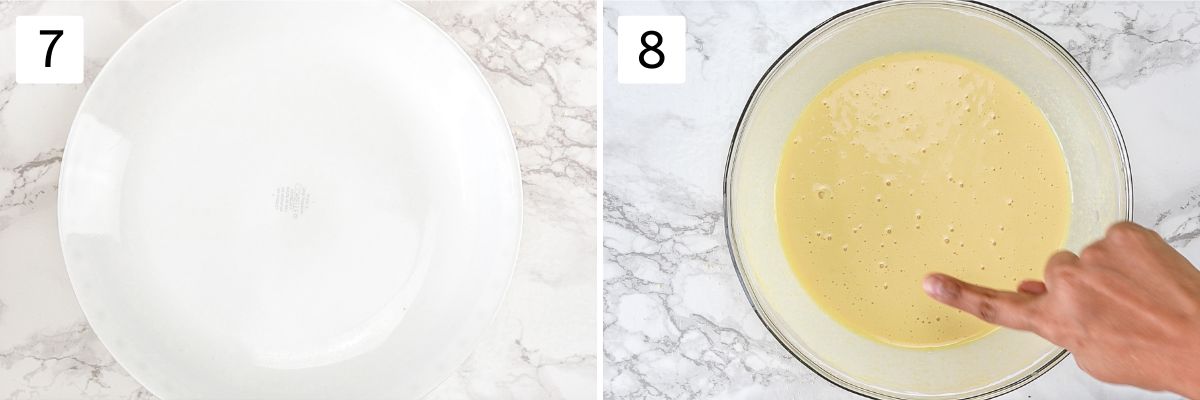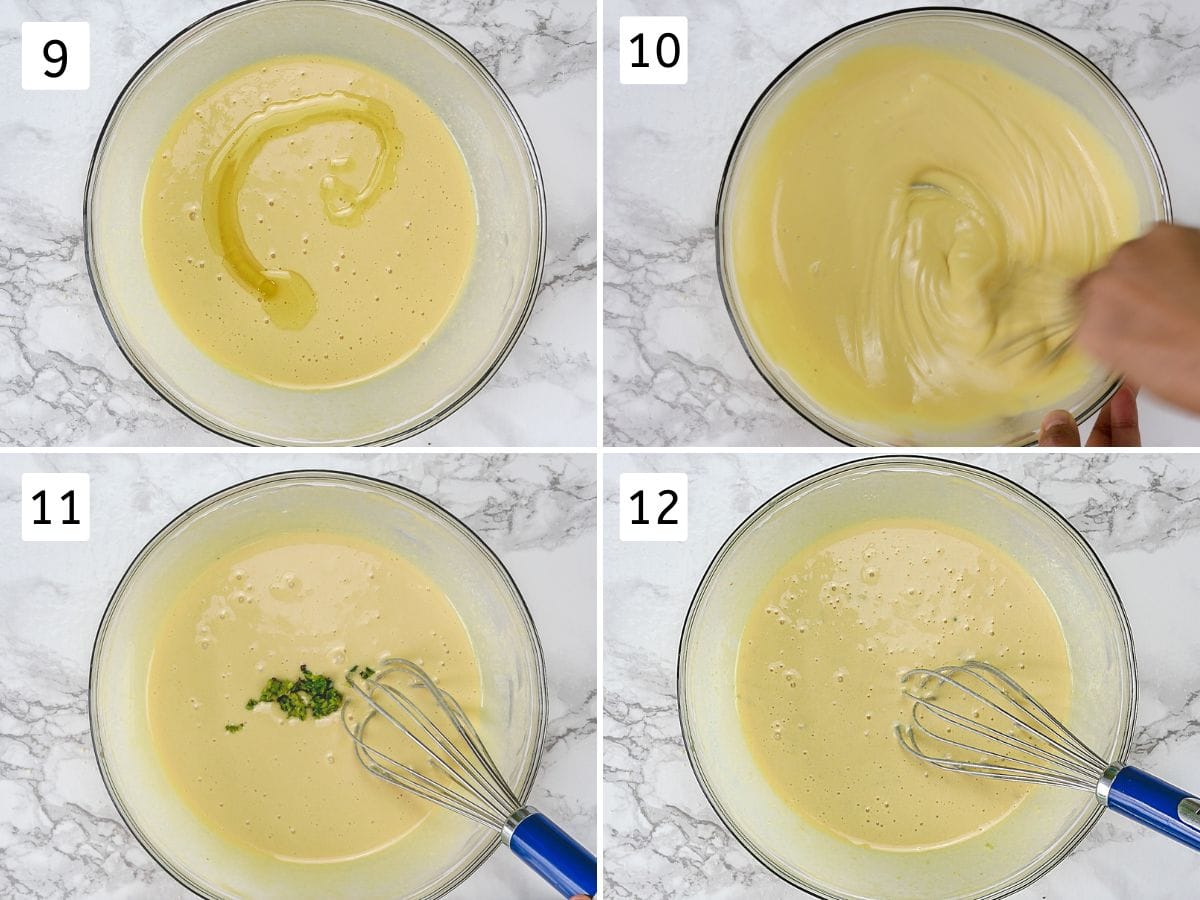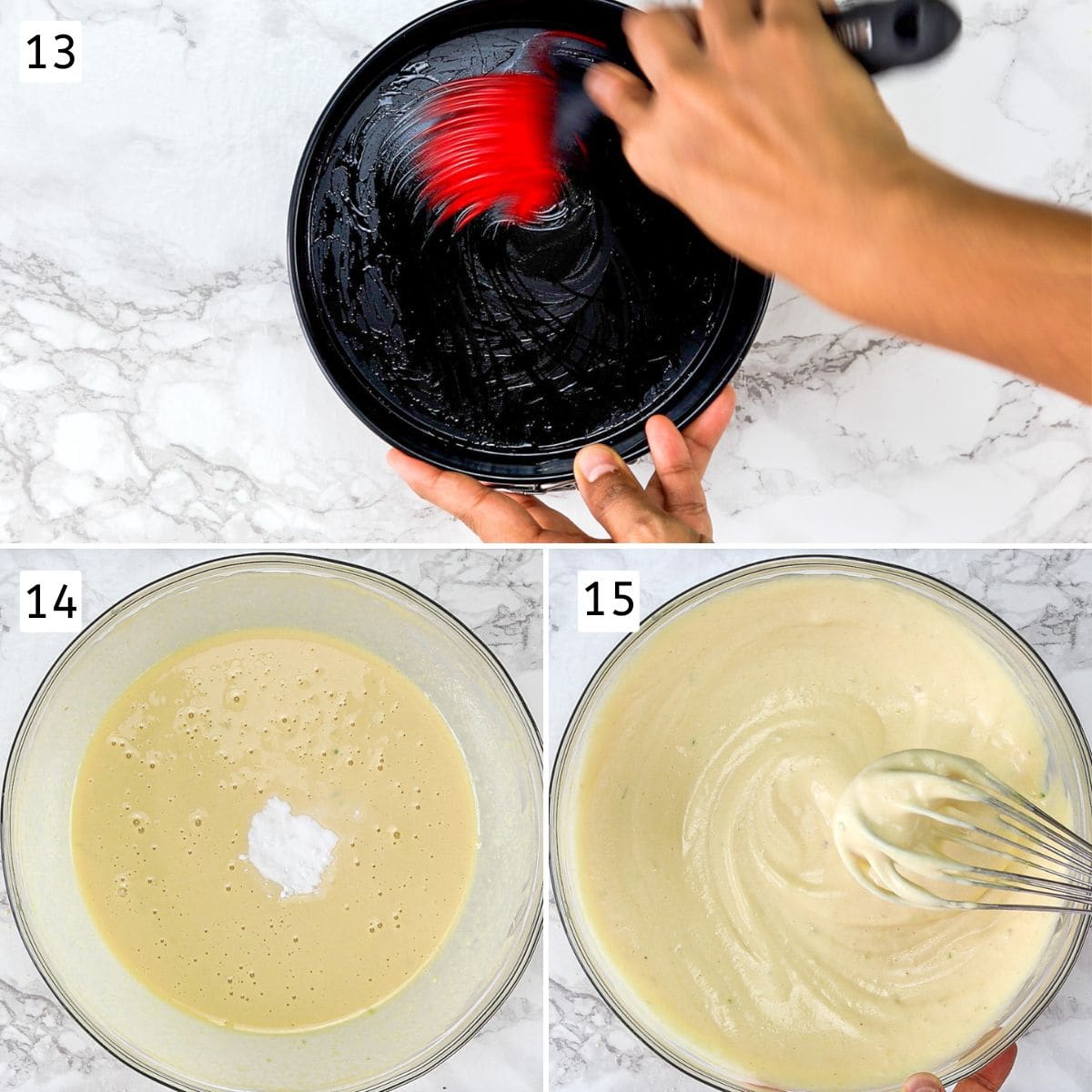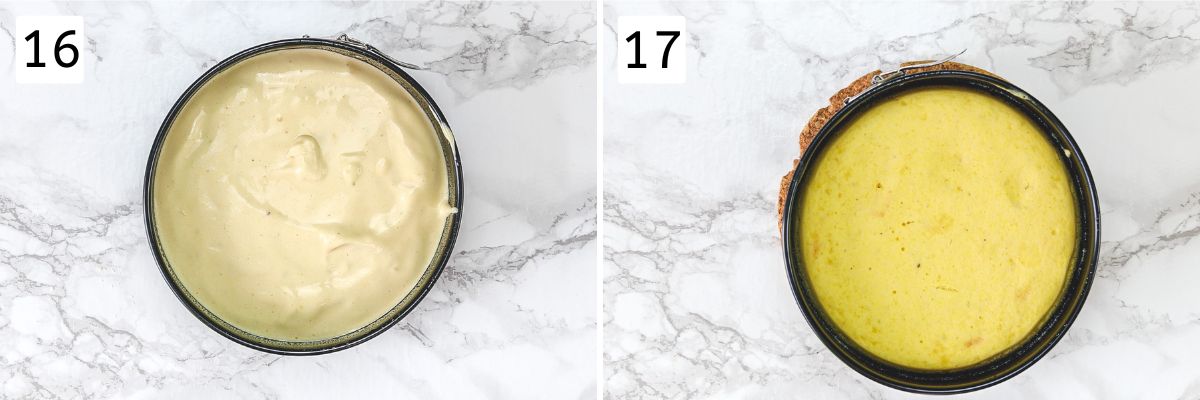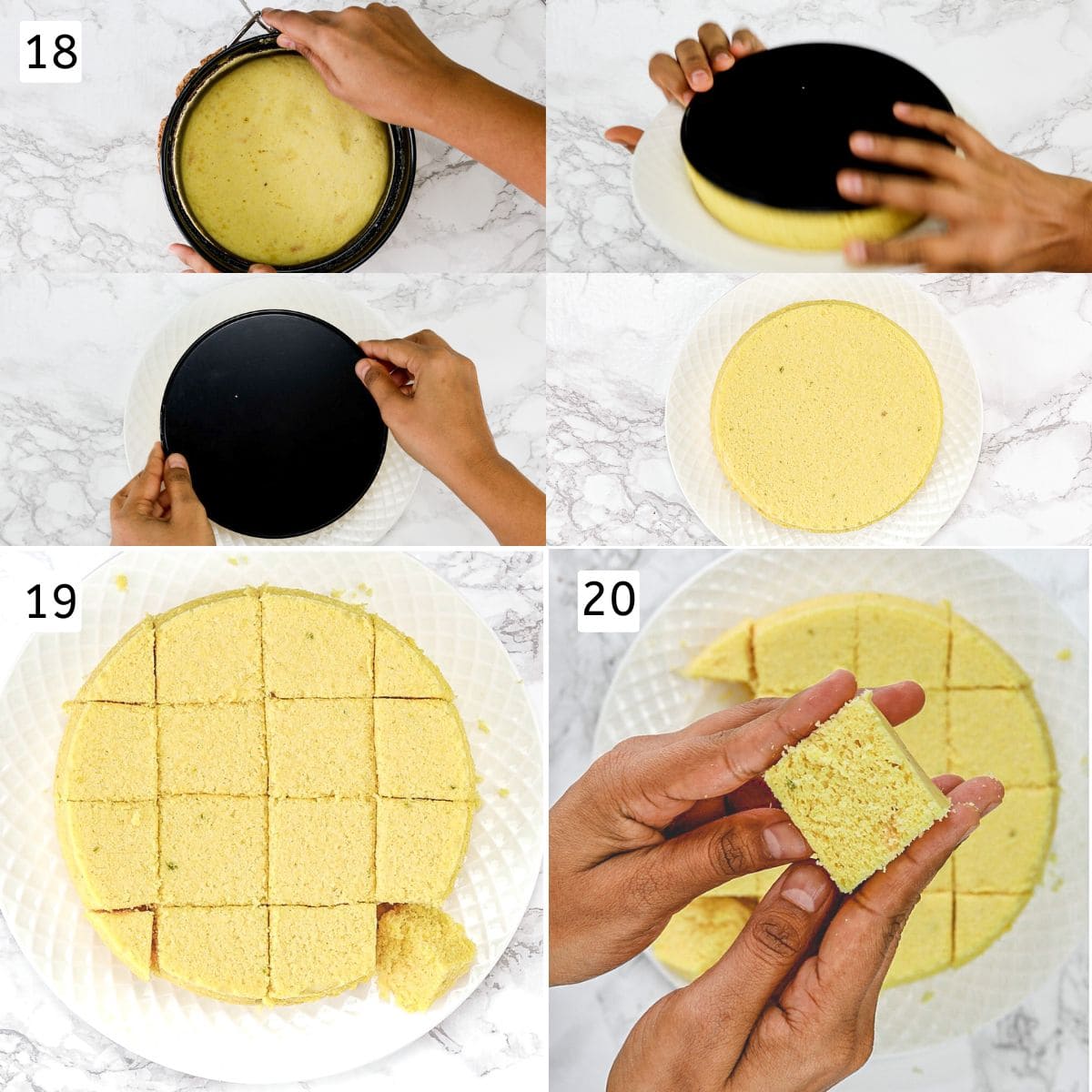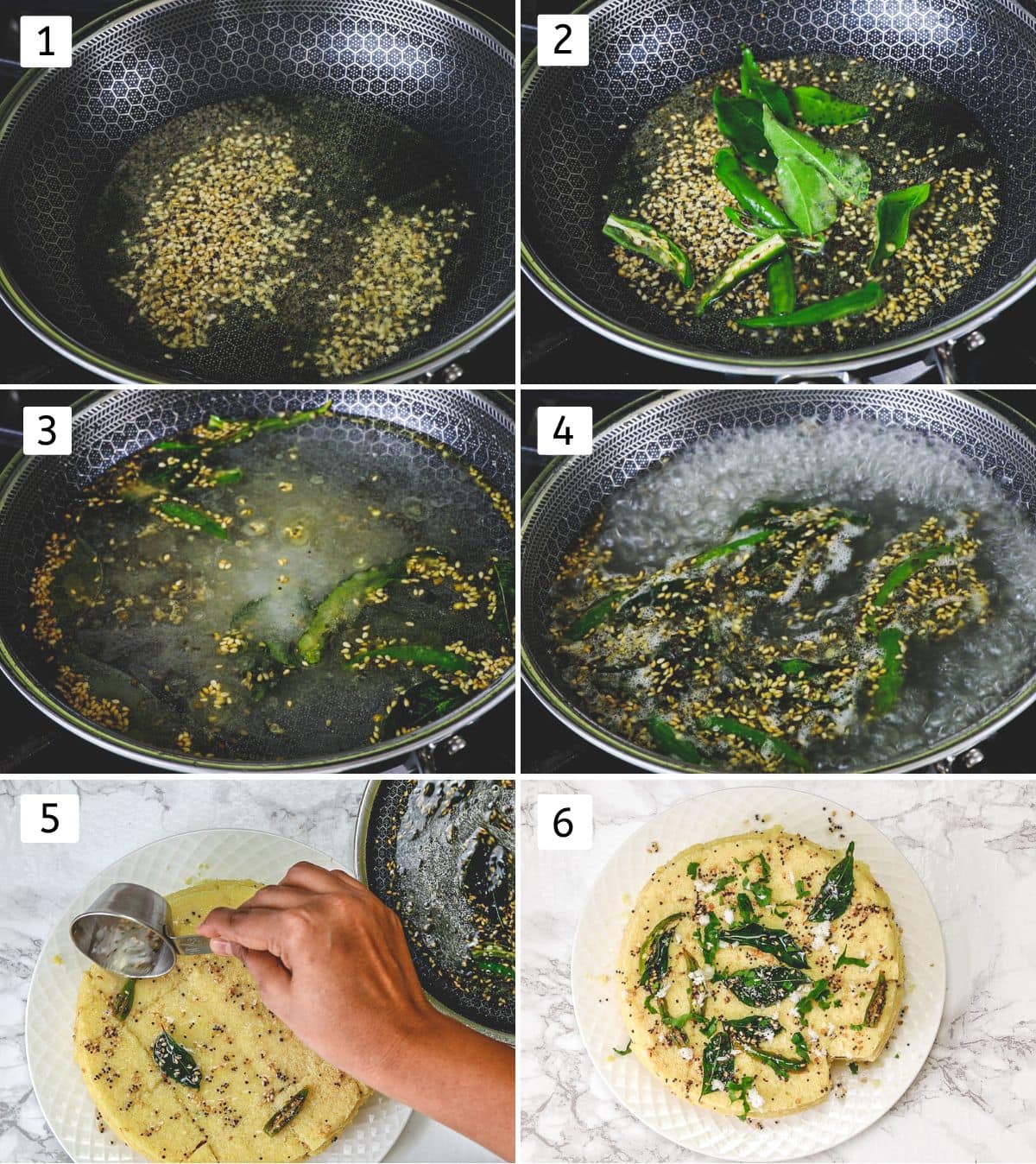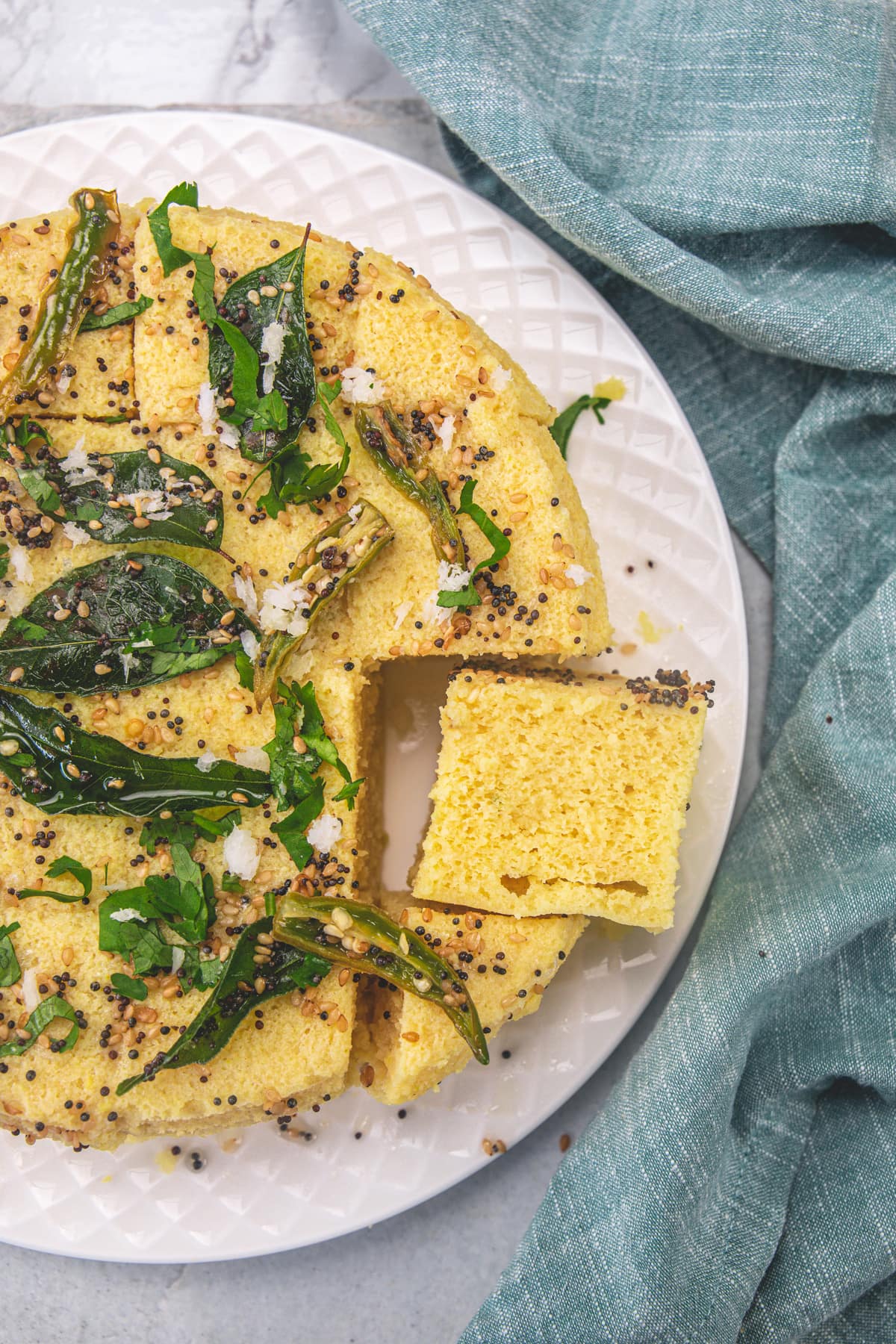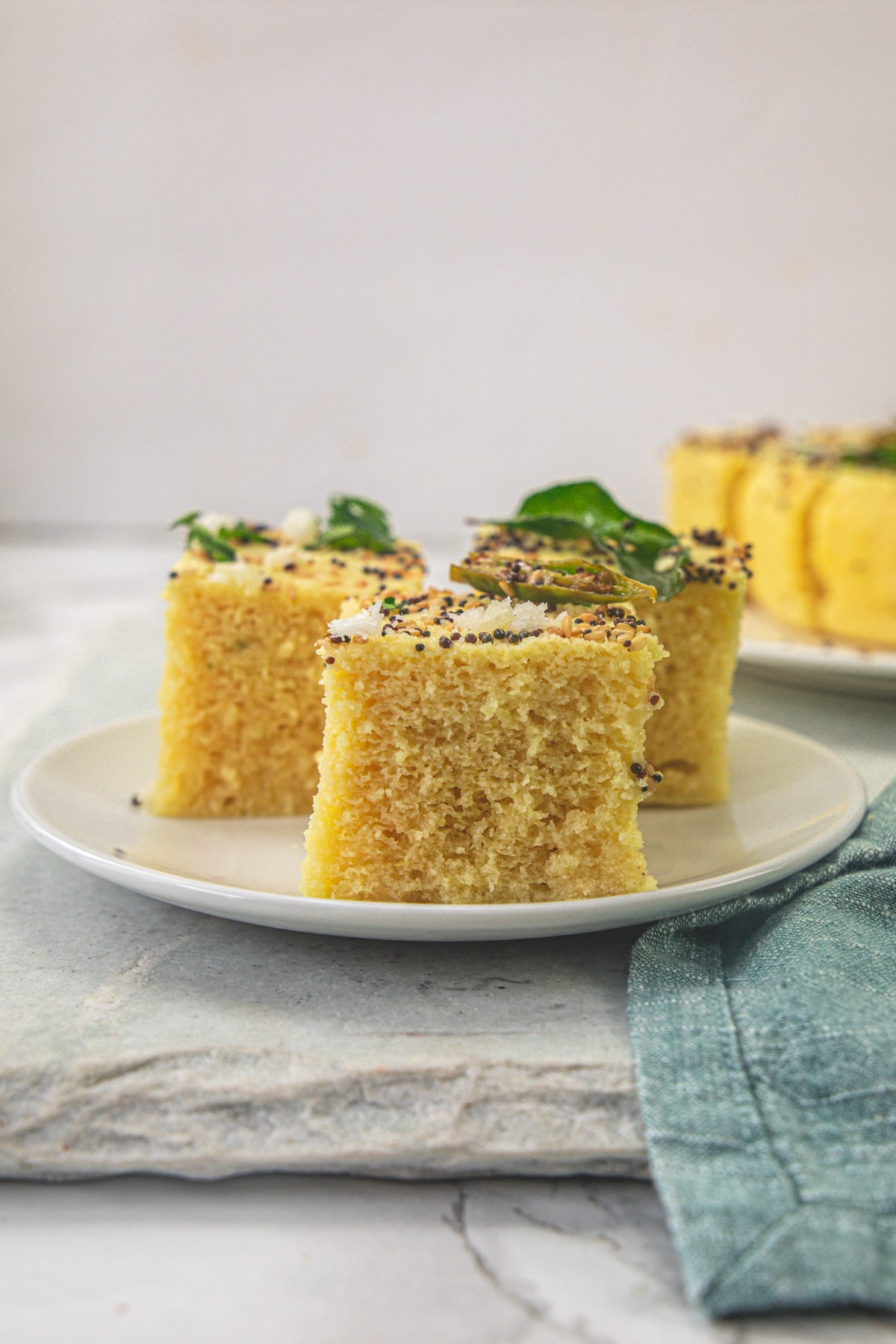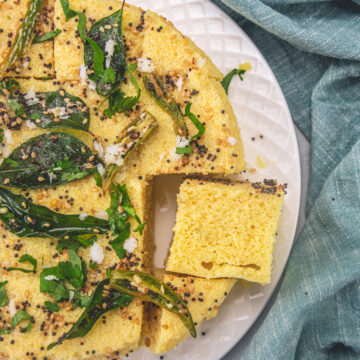This Gujarati delicacy can be enjoyed as a snack, breakfast, or as a side with your festive or elaborated meal.
Is It Khaman Or Khaman Dhokla?
If you ask any Gujarati person or If you visit Gujarat then you’ll never hear the term ‘khaman dhokla’. Globally, this khaman recipe is known as khaman dhokla recipe. But actually, khaman and dhokla are two different dishes.
So the next question is,
Difference Between Khaman And Dhokla
Khaman:
Khaman recipe is made from chana dal or chana dal flour (aka besan). There are different variations like nylon khaman, vati dal na khaman, amiri khaman (aka sev khamani), tam tam khaman, rasawala khaman, etc. Today’s recipe is a nylon khaman recipe that is made from besan and it is an instant khaman recipe. And other variations required soaking, grinding and fermenting steps. These are tall (2 inches in thickness). It has water in the tempering. This flavored water is poured over and soaked up by steamed khaman. So they become super juicy and moist.
Dhokla:
Dhokla is made from rice and lentils (urad dal and/or chana dal). The Dhokla recipe calls for soaking lentils, grinding and fermenting steps. Though there are instant versions like rava dhokla. These are thinner than khaman. Dhokla is around 1 inch thick only. No water is added to the tempering. Dhokla is regularly made in Gujarati households as a snack or sometimes as a light dinner. While nylon khaman is kind of a treat. They are made (or bought from the farsaan shop) when making special occasion meals or for guests.
Why this khaman dhokla is known as nylon khaman? Because this khaman dhokla is as light as nylon fabric.
Taste & Flavor: Khaman dhokla has a balanced flavor of salty, sweet (from sugar), and tangy (from citric acid and lemon juice). It has a spicy flavor from green chilies. However, the spice level can be adjusted to your liking. Texture: They are super soft, light, and fluffy with a juicy and super moist texture. The juicy texture comes from the water added to the tempering.
🧾 Ingredient Notes
Here is a pic of the ingredients you’ll need to make khaman dhokla batter. For Batter:
Besan (gram flour): This is the main ingredient for making khaman dhokla. So always use fresh and good quality besan. I have always used the Laxmi brand besan here in the USA and got good results. Ginger, Green chili: Crush them together in a mortar and pestle or make a coarse paste using a wet jar of your spice grinder. Sugar: It adds sweetness and it is a must. Turmeric powder: It adds a nice yellow color. Hing: As sometimes besan is not easy to digest, hing is used to promote easy digestion. Oil: It is added to batter to keep the steamed khaman dhokla soft and moist. Citric acid: It will add a tangy flavor. To get the farsaan shop style flavor, you must use citric acid. Lemon juice won’t give the same taste and flavor. Baking soda: It is used to get an instant rise in batter and it makes the khaman spongy. In the past, I have tried this with Eno fruit salt as well. Eno gives large holes (and uneven) in the sponge while baking soda gives small, evenly distributed holes in the sponge. The small holes can retain (absorb and hold) the tempering water well. That makes the moist khaman dhokla. Vs water will pass by without retaining into the larger and uneven holes. So I prefer using baking soda over eno fruit salt.
Here is a pic of the ingredients you’ll need for tempering and garnishing. For Tempering:
Mustard seeds and Sesame seeds: A go-to seeds for steamed snacks tadka in Gujarat. Curry leaves: They add a nice flavor and aroma to the dish. Salt, lemon juice, and sugar: All three together make the tempering water flavorful. Green chilies: Always slit the green chilies and not chop. If you like spicy flavor then you take a bite of this fried chili along with a bite of khaman dhokla.
For Garnishing:
Cilantro: freshly chopped leaves are used. Grated coconut: I have used frozen grated coconut that is defrosted.
👩🍳 How To Make Khaman Dhokla Recipe?
Make Batter & Steam:
- In a large bowl, add water, sugar, salt, hing, turmeric powder and citric acid. 2 ) Whisk until sugar is dissolved.
- Sift the besan into the prepared water using a strainer.
- Whisk it until you get a lump-free batter. Notice the yellow color of batter.
- Now beat the batter in one direction for around 5-7 minutes. Yes, you’ll get good arm exercise.
- After beating, you’ll notice the batter gets lighter in color and you’ll notice so many tiny bubbles in the batter.
- Cover the bowl with a plate and let it rest for 10 minutes.
- During this resting time, bubbles will get stronger and will hold them longer.
- Add oil.
- Whisk again (not just mix) for a minute.
- Add ginger-green chili paste.
- Whisk again for another 1 minute. You’ll notice more bubbles. Keep it aside.
- Before you add baking soda to the batter, prep the steamer. Add around a glassful of water to the steamer pan, add the rack in the center, cover it with a lid, and bring the water to a simmer on medium heat. Also, grease a 6-inch round pan (bottom and sides) with oil. I have used a springform pan for easy removal.
- Once the water in the steamer starts simmering, add baking soda to the batter and drizzle a teaspoon of water on the soda to activate it.
- Whisk the batter in one direction only until you get a super fluffy and light batter. Do not overmix.
- Pour the batter into the greased pan.
- Steam for 15 minutes. Check by inserting a skewer in the center it should come out clean. Remove the pan from the steamer and let it cool for 5 minutes.
- Then remove it to a plate. Since I used a springform pan, it was easy to de-mold. But if using a regular pan then loosen the sides by running a butter knife and invert it on a plate.
- Cut into square pieces.
- You can see the sponge with small and even holes as we used baking soda (not eno). This will absorb and hold the tempering water really well. Make Tempering:
- Heat the oil in a pan on medium heat. Once hot add mustard seeds and let them splutter. Add sesame seeds and within seconds it starts to pop and fly around.
- So immediately add curry leaves and green chilies. Fry for around 40-60 seconds. You’ll notice blisters on the green chili surface.
- Add water, salt, sugar and lemon juice.
- Let the water come to a boil and simmer for 1 minute. Meantime, sugar will get dissolved.
- Let the tempering cool down for 1-2 minutes and then pour over the khaman dhokla evenly using a large ladle or a measuring cup. Do not dump in one place. You may think it’s too much water, but trust me all will get soaked up.
- Garnish with cilantro and grated coconut.
💭 Expert Tips For Best Nylon Khaman
Beating the batter is a must. Using a wire whisk beat the batter until it gets lighter in color with a ton of tiny bubbles in it. Resting the whisked batter is a must. During this resting time, those tiny bubbles will get stronger and will hold them for longer. As a result, you’ll get spongy and soft khaman after steaming. Steam them on MEDIUM heat. The size of the pan is important here to get a tall thickness. Khaman dhokla are supposed to be tall (2 inches or more). So for this amount of batter, you’ll need around 6 or 7 inches of square or round pan with high sides. If you use a bigger-sized pan then you’ll not get tall khaman dhokla. After mixing baking soda to the batter, work quickly. Do not let the batter rest after adding soda otherwise batter will lose its fluffiness. Immediately pour the batter into the greased pan and steam right away. Also, keep the steamer and pan ready before adding baking soda to the batter. Always add tempering to the warm khaman dhokla, so it absorbs the tempering water well. Pour the tempering water evenly on top and also around the sides. Do not dump in one place.
Troubleshooting Khaman Dhokla Recipe
Why my khaman dhokla has a few red or orange spots? When baking soda reacts with turmeric powder it creates orange or red spots after steaming. Why my khaman dhokla is dry? It happens if the besan is not fresh (old). Stale besan absorbs more water and so the end product will be dry. If so, add some more in the tempering.
🥣 Storage Instructions
Khaman dhokla tastes best when served fresh (the day it is made or within a few hours). However, you can store them in the refrigerator in an airtight container for around 2-3 days. To reheat, simply steam them for 1-2 minutes or microwave them for a few seconds only. Just in case, if reheated khaman dhokla gets dry then make warm water (with salt, sugar and lemon juice) and pour over the dhokla to make it moist again. No need to do the tempering part again, just the flavored water is good enough.
🍽 Serving Ideas
Snack or Breakfast: Nylon khaman can be eaten as such (no sides needed). That’s how Gujarati people eat them. However, you can serve it with green chutney. Along with meal: This can be served as a farsaan (side) along with your elaborate meal (thali). One or two pieces are more than enough as a side. This recipe makes 4 servings as a snack and 6 servings as a side for the meal.
NOTE: This recipe first published in Dec 2013. The recipe is changed slightly to make it even better as I have learned so many thing over the years.
Khichu Thepla Lilva kachori Batata poha Khandvi Muthiya Fafda
Did you try this nylon khaman dhokla recipe? I’d love to hear about it! Leave a review in the comment section below.
